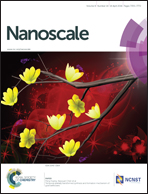Following the nanostructural molecular orientation guidelines for sulfur versus thiophene units in small molecule photovoltaic cells†
Abstract
In bulk heterojunction (BHJ) organic photovoltaics, particularly those using small molecules, electron donor and/or electron acceptor materials form a distributed network in the photoactive layer where critical photo-physical processes occur. Extensive research has recently focused on the importance of sulfur atoms in the small molecules. Little is known about the three-dimensional orientation of these sulfur atom-containing molecules. Herein, we report on our research concerning the heterojunction textures of the crystalline molecular orientation of small compounds having sulfur-containing units in the side chains, specifically, compounds known as DR3TSBDT that contain the alkylthio group and DR3TBDTT that does not. The improved performance of the DR3TBDTT-based devices, particularly in the photocurrent and the fill factor, was attributed to the large population of donor compound crystallites with a favorable face-on orientation along the perpendicular direction. This orientation resulted in efficient charge transport and a reduction in charge recombination. These findings underscore the great potential of small-molecule solar cells and suggest that even higher efficiencies can be achieved through materials development and molecular orientation control.


 Please wait while we load your content...
Please wait while we load your content...